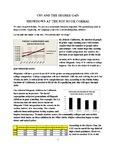- DSpace Home
- →
- CSUN ScholarWorks
- →
- CSUN University Archives
- →
- UAC 02.0 Academic Affairs
- →
- UAC 2.1 Office of the Provost and Vice President
- →
- UAC 2.1x Office of the Provost and Vice President - papers and documents
JavaScript is disabled for your browser. Some features of this site may not work without it.
| dc.contributor.author | Hellenbrand, Harold | en |
| dc.date.accessioned | 2014-09-09T19:22:14Z | en |
| dc.date.available | 2014-09-09T19:22:14Z | en |
| dc.date.issued | 2014-06 | en |
| dc.identifier.uri | http://hdl.handle.net/10211.3/126114 | en |
| dc.description.abstract | We have heard it before. We are at a crossroad. Disaster impends. The promissory note is long overdue. Typically, the language concerns a social obligation, shirked. Let us add one more to the list, “We sowed; now we reap.” By 2026 in California, the number of people in prime wage-earning years will become smaller than the number of people older and younger. One would hope that earning power would compensate for smaller size. But look at an important part of this trend. In 2026, 40% of these prime wage earners will be Hispanic. Only 17% will have college degrees. The BA is the ticket to wealth in a post-industrial society. | en |
| dc.format | application/pdf | en |
| dc.format.extent | 9 pages | en |
| dc.language.iso | en_US | en |
| dc.publisher | California State University, Northridge | en |
| dc.subject | California State University | en |
| dc.subject | California State University--Finance | en |
| dc.subject | College costs. | en |
| dc.subject | Fee increases | en |
| dc.title | CSU and the Degree Gap: Showdown at the Not So OK Corral | en |
| dc.type | Article | en |
Files in this item
This item appears in the following Collection(s)
-
UAC 2.1x Office of the Provost and Vice President - papers and documents [39]
Collection for housing California State University Northridge archival documents of CSUN Office of the Provost and Vice President


